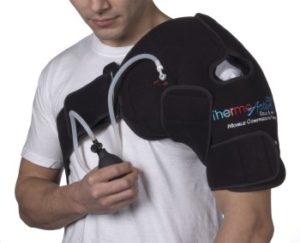Cold Compression Therapy
Cold Compression Therapy treats inflammation and pain due to athletic injuries, sprains, strains, arthritis, post-surgery pain, rehabilitation and inflammatory disorders.
We provide Cold Compression Therapy Wraps for most parts of the human anatomy which includes;
- Shoulder
- Back
- Elbow
- Wrist
- Back
- Thigh
- Knee
- Ankle
Our unique Cold Compression Therapy Wraps allows the Client to self-control the pressure with an inflating pump which is ideal for all types of sports injuries in the acute phase. Due to the comprehensive range of wraps available to BPRC we can treat all injuries from every sporting activity.
R.I.C.E (Rest, Ice, Compression, Elevation) is one of the most recommended first aid therapeutic treatment for acute musculoskeletal injuries such as sprains and strains. It is a common method used in the management of injuries and is used primarily to help reduced inflammation and the associated swelling as well as providing basic pain relief. As mentioned above the main aim of R.I.C.E to control swelling and to aid recovery time. It should be administered as soon as possible after the injury. This will result in decreased pain, inflammation, muscle spasms, swelling and tissue damage).
It is important after an acute injury to rest the affected area to protect it from further injury. The area should be protected from excessive stress but not allowed to be completely inactive. Complete inactivity will result in excessive decreases in strength and mobility of the affected soft tissues, and promote increased swelling. The load must be within the capacity of the affected tissue, when the load is higher than the capacity it may cause further injury or negatively affect the recovery of the affected tissue. It is important to determine the appropriate amount of stress the tissues can handle and ensure these are not exceeded to promote a faster recovery.
Ice therapy, also known as cryotherapy, is the application of cold as a therapeutic modality. The cold stimulates vasoconstriction of the blood vessel in the area being iced. This reduces the swelling and inflammation by limiting the amount of fluid able to perfuse into the soft tissue surrounding the injury. It also numbs the affected area by decreasing the input of nociceptive neural stimuli to the brain to reduce pain and muscle spasms.
In the acute stages of injury, the positive effects of cryotherapy outweigh the negative effects and allows for a degree of control over the inflammatory reaction. However, with the initial inflammatory reaction of the injured soft tissue reduced the negative aspects of cryotherapy will impede the recovery of the tissue. Apply ice for 10-15 minute periods every couple of hours in the first forty-eight hours after incident of injury.
After 72 hours, the initial chemical inflammatory reaction will decrease and the effects of heat will out weight the effects of ice. Heat will result in increased circulation, relaxes muscle tension and reduced joint stiffness. In addition, it will also help to prepare tissues for rehabilitation.
Compression of the injured area helps to immobilize and protect the joint. It also helps to reduce swelling in the area by increasing the pressure within the tissues this results in decreased perfusion of the soft tissue, which help to prevent excessive swelling.
The injured area must immediately be raised, preferably to a level above the heart. This allows gravity to drain the excess fluid from around the injured tissue back to the central circulation, resulting in decreased swelling. As the pressure in the injured area is reduced, this will reduce pain and allow for transport of cellular waste products towards the heart which helps the recovery of the tissue by re-establishing the cellular and extracellular homeostasis.
For further details please contact our Client Care Team.
Telephone: 00 973 35193767
Email: [email protected]

